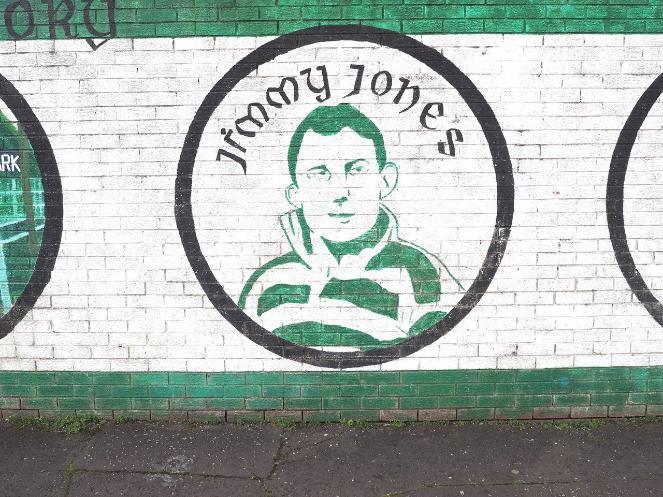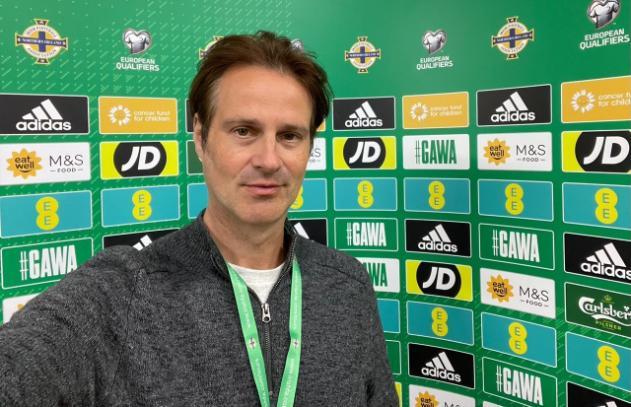A Brief History of Football and Sectarianism in Northern Ireland
10/01/2025 - 9.31
Chris Lee
Ireland can boast one of the world’s oldest football cultures. It’s also a perfect example of how football can reflect the sociopolitical situation of a country. In this article focussing on the relationship between football and conflict, based on my new book on discovering Irish football as an outsider, I examine how football came to mirror political events in Ulster.
On 11 October 1974, a one-armed man was walking to his job at a bookmaker in Belfast. But he wouldn’t make it to work that day. He would die in the arms of a passer-by, having been shot in the back by loyalist paramilitaries. The victim’s name was Jimmy Hasty, and in his previous career as a footballer, he had scored 103 goals in 169 matches – most notably for Dundalk in the League of Ireland, despite losing his arm at 14 in an industrial accident.
Hasty left behind a widow and two sons. The Drogheda Independent recorded Hasty as the 1,085th victim of the Troubles, the name for the period of sectarian violence that erupted in the late 1960s in Northern Ireland and lasted until the Good Friday Agreement in 1998.
Hasty’s death was a cynical tit-for-tat killing; he was not a political figure. But he was a victim of the times, and football had experienced political violence in the north of Ireland since the late Victorian era.
Historical Context: Football and Demography in Ulster
Association football entered Ireland in an organised way in the late 1870s. The then-unified island of Ireland was, in its entirety, part of the United Kingdom. Much of the population of the north of the island – mainly the province of Ulster – were descended from people who arrived in the 16th and 17th centuries as part of the ‘plantation’ of Protestants from England and Scotland on previously Irish-owned land.
This led to a Protestant majority in the north of Ireland at the time when a new national awakening was emerging across the island against British rule in the later part of the 19th century. There had been football games amongst British regiments before the ‘father of Irish football’, John McCredy McAlery, founded Ireland’s first football club, Cliftonville, in 1879. This military connection led to soccer being known as the ‘garrison game’ by Irish nationalists.
McAlery formed the Irish Football Association (IFA) in 1880, and a knock-out cup competition, the Irish Cup, followed a year later. The world’s second-oldest league, the Irish League, was established in 1890.
Football took off in Belfast, where an industrial base and close links to Scotland helped it grow, compared to the slower development in the administrative capital, Dublin. However, in Belfast by the 1890s, the social divisions between the Catholic and Protestant communities became evident in football matches. Violence erupted between fans of the leading Catholic club, Belfast Celtic, and those from Protestant East Belfast, most notably Linfield and Glentoran. With shipbuilding being such a big employer in the city, Belfast football fans had easy access to nuts and bolts, which - when deployed as projectiles aimed at rival fans - became known as ‘Belfast confetti’. While there were doubtless brawls at football matches in Britain at this time, one could argue that organised, politically motivated football violence anywhere in the world was first seen in Belfast.
1921: The Split
As support for ‘Home Rule’, which would give Ireland a limited running of its own affairs within the United Kingdom, swelled in the first decade of the 20th century, the Unionist counterpoint grew in the Protestant-majority north, and armed groups emerged. Only the outbreak of the Great War in 1914 prevented all-out civil war, although conflict was merely delayed.
The 1916 Easter Uprising in Dublin was followed by the Irish War of Independence (1919-21), resulting in the Anglo-Irish Treaty. The treaty led to the creation of the Irish Free State in 26 counties, while six Protestant-majority counties in Ulster remained in the United Kingdom as Northern Ireland.
Football was caught up in the split as the Dublin-based Leinster Football Association elected to break away from the Belfast-based IFA. The Leinster clubs had long been disaffected with a perceived Belfast bias on Irish national team selection and venue choice for international matches. The breakaway led to the formation of what is now the Football Association of Ireland (FAI), and the formation of the League of Ireland and the FAI Cup.
So, unlike cricket, rugby union and Gaelic games, which continue to this day as all-Ireland affairs, soccer became split into the Irish League in Northern Ireland and the League of Ireland in what is now the Republic of Ireland, with two separate national sides.
Belfast Celtic: The Lost Giant of Irish Football
Belfast Celtic were formed in 1891, in the mainly Catholic Falls Road area of the city. They were inspired by their Glaswegian namesakes and eventually adopted the same green-and-white hooped shirts. The Celts twice pulled out of the Irish League due to sectarian violence. Firstly, in 1920, after growing trouble between the club’s fans and supporters of Protestant clubs. In the tense climate of the Irish War of Independence, political symbols were displayed, and sectarian songs were sung at matches, leading to violent exchanges. A referee was even attacked in a game between The Celts and Glentoran in 1919.
Belfast Celtic rejoined the Irish League in 1924, but the club’s second withdrawal after the 1948/49 season was terminal. A fraught derby with Linfield at Windsor Park on 27 December 1948 ended with Belfast Celtic’s Protestant striker Jimmy Jones being savagely attacked by a Linfield mob intent on causing injury. They stamped on Jones’s leg, breaking it, and he was lucky to survive the beating. Remarkably, Jones recovered and returned to football and remains the Irish League’s top goal-scorer to this day.

Mural to Belfast Celtic’s Jimmy Jones, near Falls Road in Belfast. Source: Author's Collection
The incident was the last straw for The Celts, who withdrew from the Irish League entirely and went on tour to the US. Belfast Celtic played just over half a century of senior football between 1896 and 1949, yet The Celts remain the third most successful club in the history of Northern Irish football with 14 championships and eight cup wins.
The Celts’ ‘Paradise’ ground is now covered by a shopping centre, but enthusiasts from the Belfast Celtic Society (https://www.belfastceltic.org/museum/index.html) keep a small museum in a unit there, which is well worth a visit.
Derry City: Playing South of the Border
Another club lost to Northern Irish football due to the political turmoil is Derry City. Although geographically within the United Kingdom, Derry City has played south of the border in the League of Ireland since 1985.
Derry/Londonderry was a key flashpoint of the Troubles, and the majority Catholic/nationalist/republican Bogside district – near Derry City’s ground, The Brandywell – was the scene of ‘Bloody Sunday’ on 30 January 1972, where 14 civilians were shot dead by British soldiers.
Even before Bloody Sunday, it was becoming hard to host football at The Brandywell; Linfield refused to travel there, and Ballymena United’s bus had been torched. Derry City was forced to play home matches up at Coleraine but failed to draw crowds, so resigned from the Irish League. The club was stuck in junior football until a group of former players submitted a plan to take Derry City into the League of Ireland. Crucially, they secured the approval of UEFA, FIFA and both FAs on the island of Ireland to play south of the border.
Derry City fitted in straight away and, within four years, had won a historic treble of Premier Division, FAI Cup and League Cup. It was the first time this had been done, and it gave Derry City the distinction of having won the league and cup in two different national leagues.
Derry City’s matches are overseen by club stewards rather than the Police Service of Northern Ireland (PSNI), the successor to the Royal Ulster Constabulary (RUC).
Football and the Troubles
While football was often a focal point for inter-community rivalry during the Troubles, there were thankfully few fatalities around football. In January 1980, an RUC officer was killed in an Irish Republican Army (IRA) drive-by shooting while on duty outside Crusaders’ Seaview ground for their home match with Portadown. The attack followed a similar drive-by shooting at Seaview two years previous, where a woman had been killed and an officer injured.
Even rural club Loughall FC, which holds the record for the smallest town in European football to boast a top-flight football club, saw its clubhouse damaged in an IRA attack on the nearby police station in the late 1980s.
Due to shifting demographics, Cliftonville – founded by John McAlery – over time became supported by a traditionally Catholic/republican/nationalist fan base. It was very much the outlier in the Irish League after the loss of Belfast Celtic and Derry City. As recently as 1991, Cliftonville fans narrowly avoided tragedy when a hand grenade exploded near them in an away match at Linfield’s Windsor Park. The playing of the British anthem God Save the King/Queen before cup finals featuring Cliftonville has also proved divisive in recent years.
Thankfully, by the time of my visit to Cliftonville, more than a quarter of a century of peace has allowed Northern Ireland to flourish. In football, there are still isolated incidents and clubs are fined for sectarian chanting by their fans, but clubs have been very successful in outreach and using football as a tool for community cohesion.
Reference
Drogheda Independent, 18 October 1974, page 17. A 2024 documentary cites Hasty as the 1,205th victim of the Troubles (https://www.irishnews.com/news/northern-ireland/documentary-on-murdered-one-armed-belfast-soccer-star-jimmy-hasty-wins-sports-emmy-64CISH363NGMPK3X5LJ7DPYF6I/).
Biography
Chris Lee is the founder and editor of the football history, culture, and travel blog and podcast Outside Write (https://outsidewrite.co.uk). His third book, Shades of Green: A Journey into Irish Football (https://www.pitchpublishing.co.uk/shop/shades-green), comes out on 10 March via Pitch Publishing and is available for pre-order now. His book mostly focuses on the wider history and groundhopping in the League of Ireland and the Northern Ireland Football League (NIFL – also known as the Irish League) rather than conflict, although there is a fair deal of politics throughout the book.



/prod01/wlvacuk/media/departments/digital-content-and-communications/images-2024/Diane-Spencer-(Teaser-image).jpg)
/prod01/wlvacuk/media/departments/digital-content-and-communications/images-18-19/220325-Engineers_teach_thumbail.jpg)
/prod01/wlvacuk/media/departments/digital-content-and-communications/images-2024/240509-Menopause-Research-Resized.jpg)
/prod01/wlvacuk/media/departments/digital-content-and-communications/images/Maria-Serria-(teaser-image).jpg)
/prod01/wlvacuk/media/departments/digital-content-and-communications/images-2024/241014-Cyber4ME-Project-Resized.jpg)
/prod01/wlvacuk/media/departments/digital-content-and-communications/images-2024/240315-Research-Resized.jpg)
/prod01/wlvacuk/media/departments/digital-content-and-communications/images-2024/BDA-group-photo.jpg)